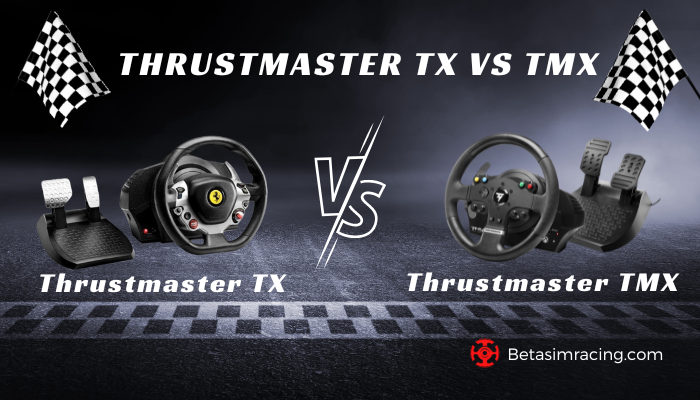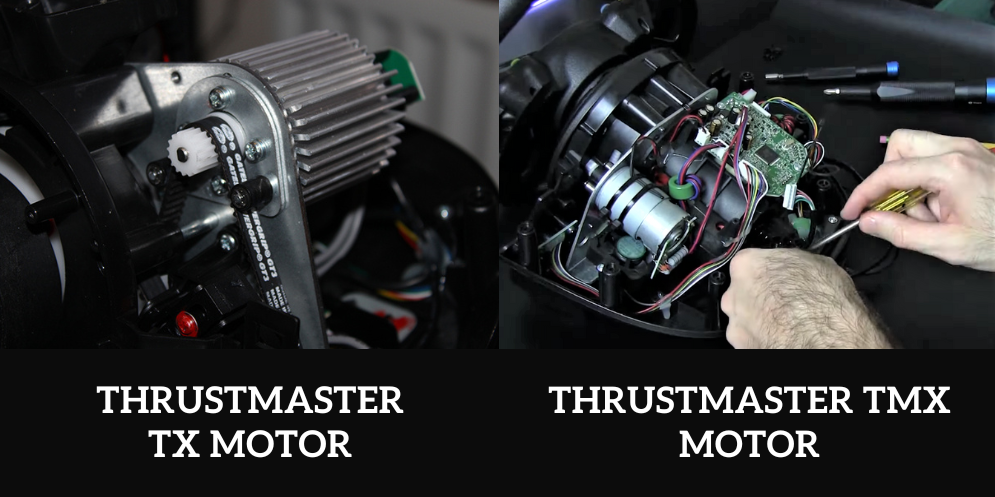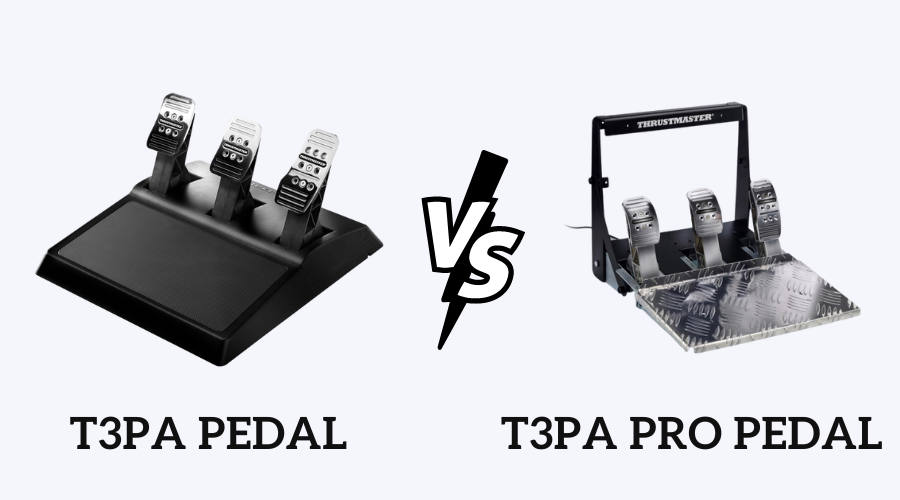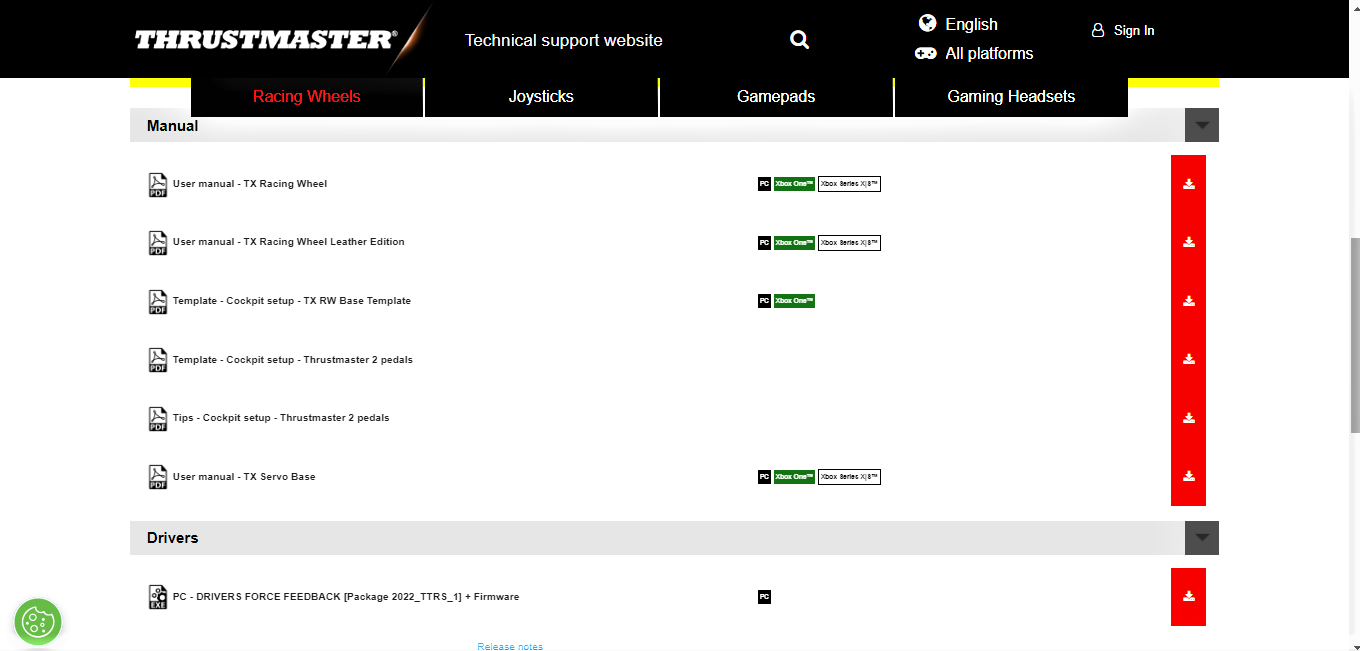Deciding between the Thrustmaster TX and Thrustmaster TMX is a common crossroads for enthusiasts entering the world of sim racing. Both wheels offer a significant leap from a standard controller, providing force feedback and precision for Xbox and PC gamers. However, they are engineered for different users and price points. The TX is a mid-range system focused on performance and modularity, while the TMX serves as a highly capable entry-level option.
This purely informational guide provides an objective, in-depth comparison of their specifications and features. We will dissect the technology, build quality, and ecosystem to provide a clear understanding of each wheel, helping you determine which aligns with your sim racing goals and budget. Making an informed decision is a critical first step when building your sim racing setup.
Thrustmaster TX vs. TMX: At a Glance Comparison
This table provides a direct comparison of the most critical specifications for both racing wheels.

| Feature | Thrustmaster TX | Thrustmaster TMX |
| Force Feedback Motor | Brushless Servomotor | Brushed DC Motor |
| Drive System | Dual-Belt System | Hybrid Belt-Pulley & Gear System |
| Max Rotation Angle | 900° | 900° |
| Steering Precision | 16-bit (65,536 values) | 12-bit (4,096 values) |
| Position Sensor | H.E.A.R.T. Magnetic Sensor | Optical Sensor |
| Interchangeable Rim | Yes (Thrustmaster Ecosystem) | No (Fixed Rim) |
| Standard Pedals | T3PA (3-pedal, metal) | Standard (2-pedal, plastic) |
| Rim Materials | Varies by package (e.g., Leather) | Rubber and Plastic |
| Primary Compatibility | Xbox Series X|S, Xbox One, PC | Xbox Series X|S, Xbox One, PC |
| Mounting System | Desk Clamp & Hard Mount Screws | Desk Clamp Only |
| Target User Level | Enthusiast / Mid-Range | Beginner / Entry-Level |
| Ecosystem Ready | Full (Pedals, Shifter, Rims) | Partial (Pedals, Shifter) |
Understanding the Core Differences: Technology and Performance
While both wheels provide force feedback, the way they generate and deliver those forces is fundamentally different. This is where the price and performance gap becomes most apparent.
Force Feedback: Brushless Dual-Belt vs. Hybrid System
The engine of a racing wheel is its motor and drive system. This technology dictates the quality, strength, and smoothness of the force feedback effects you feel.
The Thrustmaster TX features a brushless servomotor connected to a dual-belt drive system.
- What this means: A brushless motor is more efficient, powerful (~25 watts), and generates less internal friction than a brushed motor. The dual-belt system ensures that the motor’s power is transmitted to the wheel smoothly and quietly.
- User Experience: The result is highly detailed, responsive, and fluid force feedback. You can feel subtle changes in the road surface and tire grip without the notchy or cogging sensation sometimes present in gear-driven systems. This is a significant step towards realism and is closer in feel to high-end direct drive wheels.
The Thrustmaster TMX uses a brushed motor with a hybrid belt-pulley and gear system.

- What this means: This system combines a belt for smoothness with gears for strength. It’s a clever and cost-effective design that delivers true force feedback, a major improvement over non-feedback wheels.
- User Experience: The TMX provides solid feedback effects, allowing you to feel understeer, oversteer, and impacts. However, it is generally less powerful and detailed than the TX. Some users may notice a slightly less smooth feeling during rapid steering changes due to the presence of gears in the system.
Key Takeaway: The TX’s brushless dual-belt system delivers stronger, smoother, and more nuanced force feedback. The TMX’s hybrid system is very effective for an entry-level wheel but lacks the refinement and power of the TX.
Rotational Precision: 16-Bit H.E.A.R.T. vs. 12-Bit Optical
Precision determines how accurately the wheel translates your physical movements into the game.
The Thrustmaster TX is equipped with Thrustmaster’s H.E.A.R.T. (HallEffect AccuRate Technology). This is a contactless magnetic sensor that reads the wheel’s position with 16-bit resolution. This translates to 65,536 distinct values in its rotation. Because the sensor is magnetic, there is no physical wear, meaning its precision will not degrade over time.
The Thrustmaster TMX uses a more conventional optical sensor with 12-bit resolution, which provides 4,096 values. While this is ample precision for most racing scenarios, especially at the entry level, it is objectively a lower resolution than the TX. It allows for precise control, but the TX can register smaller, more minute steering inputs.
Build Quality, Materials, and Ergonomics
The physical construction and included accessories are another major point of differentiation that contributes to the overall user experience.
The Wheel Rim: Swappable vs. Fixed
A key feature of the Thrustmaster TX is its interchangeable wheel system. The servo base is compatible with Thrustmaster’s entire ecosystem of add-on rims. This allows you to swap the stock wheel for a GT-style, F1-style, or rally-style rim, such as the popular Thrustmaster Ferrari F1 wheel. This modularity is a significant advantage for serious racers who enjoy different disciplines.
The Thrustmaster TMX, in contrast, has a fixed wheel rim. The included 28 cm wheel is ergonomically designed with rubber grips and is well-suited for a variety of racing types, but it cannot be removed or replaced.
The Pedal Set: A Tale of Two Tiers
The included pedals often represent the most significant initial difference in package value.

- The Thrustmaster TX is commonly bundled with the T3PA pedal set. This is a 3-pedal unit (throttle, brake, clutch) with metal pedal faces. The brake pedal also includes a conical rubber mod that adds progressive resistance, offering a more realistic braking feel.
- The Thrustmaster TMX typically comes with a more basic 2-pedal set. This unit is made almost entirely of plastic and includes only a throttle and brake. The brake pedal has some progressive resistance but lacks the advanced feel and adjustability of the T3PA.
For users of either wheel, upgrading the pedals is a popular path. It is possible to calibrate Thrustmaster pedals like the T3PA-PRO for an even better experience.
The Thrustmaster Ecosystem: Upgradability and Future-Proofing
Both wheels serve as an entry into Thrustmaster’s ecosystem, but the TX offers a much wider path for upgrades.
| Upgrade | Thrustmaster TX | Thrustmaster TMX |
| Wheel Rims | ✅ Yes | ❌ No |
| Pedal Sets | ✅ Yes (e.g., T-LCM, T3PA-PRO) | ✅ Yes (e.g., T-LCM, T3PA) |
| Shifters | ✅ Yes (e.g., TH8A, TH8S) | ✅ Yes (e.g., TH8A, TH8S) |

The ability to change wheel rims on the TX is its defining advantage in terms of future-proofing and customization. For the TMX, while the rim is fixed, users can still significantly enhance their experience by adding a manual shifter or a higher-quality pedal set.
Target Audience: Which Wheel Is Built for You?
The choice between these two wheels ultimately comes down to your budget, your current level of dedication to sim racing, and your future aspirations.
The Case for the Thrustmaster TMX
The TMX is an excellent choice for:
- Beginners: It offers a genuine force feedback experience without a high initial investment.
- Casual Racers: If you enjoy sim racing games but don’t plan to build a dedicated cockpit, the TMX is a perfect upgrade from a controller.
- Budget-Conscious Buyers: It provides the best force-feedback performance at its price point, making it a direct competitor to products like the Logitech G920.
The Case for the Thrustmaster TX
The TX is the ideal option for:
- Aspiring Enthusiasts: If you see sim racing as a long-term hobby, the TX provides a stronger foundation to build upon.
- Users Who Value Smoothness: The dual-belt system offers a superior feel that is immediately noticeable.
- Those Who Plan to Upgrade: The interchangeable rim system is the gateway to a deeply customizable racing experience.
Mounting and Installation
Both wheels include a desk clamp for easy setup. However, the Thrustmaster TX also includes built-in screw threads, making it designed for hard-mounting to a dedicated racing wheel stand or a full sim racing cockpit. This provides maximum stability during intense racing sessions.
The TMX is intended primarily for desk use, and while it can be secured to some stands, the TX offers a more robust and versatile mounting solution for dedicated setups.
Final Analysis: Which One Should You Choose?
There is no single “best” wheel; the ideal choice depends entirely on the user.
- Choose the Thrustmaster TMX if you are new to sim racing, have a limited budget, or want a significant but cost-effective upgrade from a gamepad. It delivers an authentic force feedback experience and is the undisputed performance leader at the entry-level price point.
- Choose the Thrustmaster TX if you are serious about sim racing, value smoother and more powerful force feedback, and want the ability to customize your setup with different wheel rims in the future. The higher initial cost is an investment in superior performance and long-term adaptability.
Frequently Asked Questions (FAQ)
Is the Thrustmaster TX still a good wheel?
Yes, absolutely. The Thrustmaster TX remains a highly respected mid-range wheel. Its brushless, dual-belt force feedback system and ecosystem compatibility provide performance and features that are still highly competitive and sought after by sim racing enthusiasts.
Can you upgrade the pedals on the Thrustmaster TMX?
Yes. The TMX base is fully compatible with Thrustmaster’s separate pedal sets, including the 3-pedal T3PA and the high-end T-LCM load-cell pedals. Upgrading the pedals is one of the most effective ways to improve the TMX experience.
Is the Thrustmaster TX better than the Logitech G920?
The Thrustmaster TX and the Logitech G920 are often compared, but they use different technology. The TX uses a smoother and quieter dual-belt system, while the G920, like its counterpart the G29, uses a gear-driven system. Most enthusiasts consider the TX’s force feedback to be superior in quality and feel. However, the TMX is the more direct competitor to the G920 in terms of price and market position.
What is the main advantage of the TX’s brushless motor?
The main advantages are efficiency, smoothness, and durability. A brushless motor can deliver more powerful and detailed force feedback effects with less noise and heat compared to the brushed motor in the TMX. It also has a longer operational lifespan due to the lack of physical brushes to wear out.
Do I need a wheel stand for the TX or TMX?
You don’t need one, as both come with desk clamps. However, for the best experience, a wheel stand is highly recommended, especially for the more powerful TX. A stand prevents the wheel from moving during aggressive driving and allows for a more stable and ergonomic placement of the wheel and pedals.
Are the TX and TMX compatible with Xbox Series X/S and PC?
Yes, both the Thrustmaster TX and TMX are officially licensed for Xbox and are fully compatible with Xbox Series X|S, Xbox One, and PC. Windows requires drivers which can be downloaded from the Thrustmaster support website.

With a background in mechanical engineering and over a decade in competitive sim racing, Kenji serves as our lead Sim Racing Physics & Hardware Analyst. He deconstructs complex topics like force feedback and suspension geometry, helping readers understand the crucial engineering behind a perfect lap time. Kenji’s passion is to translate real-world motorsport principles into actionable knowledge for the sim racing community.
